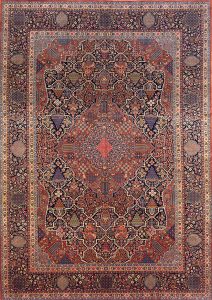Biography of Dabir and Dabir Rugs – Kashan Dabir Rugs: A Masterpiece of Persian Elegance

There is very limited personal biographical information available about the individual Dabir from the famed Kashan Dabir rug workshop, primarily because Persian carpet weaving traditions typically emphasize collective craftsmanship over individual fame. However, here is what is known or historically inferred.
Who Was “Dabir”
The name “Dabir” (دبیر) means “scribe” in Persian, and it is the family name of the founder and master of the Dabir workshop. The primary figure is Haj Molla Mohammad Dabir, who lived during the late 19th century, approximately 1880–1930, during the Qajar and early Pahlavi periods in Kashan, Iran.
He established the Dabir workshop, and he became famous for producing extraordinarily fine rugs, rivaling even those of the Mohtasham family, who were also legendary Kashan weavers.
Dabir rugs, also known as Kashan Dabir rugs, are among the finest examples of Persian carpet weaving, renowned for their elegance, precision, and exceptional artistry. Originating from the city of Kashan in central Iran, these rugs reflect the highest standards of craftsmanship and were often associated with royal courts and the elite class during the late 19th and early 20th centuries.
The Dabir workshop was founded by the Dabir family, particularly Master Haj Molla Mohammad Dabir, who established a prestigious weaving workshop in Kashan during the late 19th century.
The production of Dabir rugs peaked during the Qajar dynasty (1789–1925) and extended into the early Pahlavi period. These rugs were often commissioned by Persian nobility and exported to Europe, where they gained acclaim at international exhibitions.
Cultural significance of Kashan Dabir Rugs
The cultural significance of Dabir rugs is profound, as these carpets are not only masterpieces of Persian craftsmanship but also deeply rooted in the artistic, historical, and social identity of Iran.
Kashan Dabir rugs represent the zenith of Persian carpet artistry, particularly from the late 19th to early 20th century. Their fine weaving, intricate designs, and luxurious materials reflect the sophistication of Persian aesthetics. They were often compared to paintings woven in wool and silk, showing that they were valued as fine art, not just textiles.
Dabir rugs were frequently commissioned by the Qajar aristocracy and the Pahlavi elite, making them symbols of power, refinement, and prestige. Owning a Dabir rug was a mark of elite taste, often used to decorate royal reception rooms and palaces. Some rugs were specially created as diplomatic gifts, highlighting their cultural importance beyond Iran’s borders.
Many motifs in Dabir rugs—like the central medallion or Garden of Paradise designs—carry spiritual symbolism, representing the divine order, unity, or paradise. They were commonly used in religious and ceremonial contexts, such as prayer rugs, or given as offerings to shrines and mosques.
Dabir rugs are a reflection of intergenerational knowledge, encompassing weaving techniques, natural dye recipes, and design blueprints that have been passed down over centuries. They helped preserve Kashan’s weaving identity during times when machine-made rugs were threatening handmade traditions.
Their survival in collections and museums today helps educate younger generations about the Persian art heritage. Dabir rugs were featured in World’s Fairs and international exhibitions, serving as cultural ambassadors of Iran. European and American collectors sought them for their beauty, raising global awareness of Persian culture and creating a lasting international legacy.
Patterns in Dabir rugs often reflect Sufi philosophy, Persian poetry, and mathematical symmetry, turning each carpet into a layered intellectual object. Their balanced geometry and botanical motifs express the Persian worldview—harmony between man, nature, and the cosmos.
In summary, Kashan Dabir rugs represent the golden revival of Persian carpet weaving at the turn of the 20th century—they are woven expressions of Persian identity, philosophy, and beauty. They hold an esteemed place in Iranian cultural memory and continue to be treasured worldwide for both their artistic merit and historical significance. These rugs remain among the most collectible Persian carpets today.